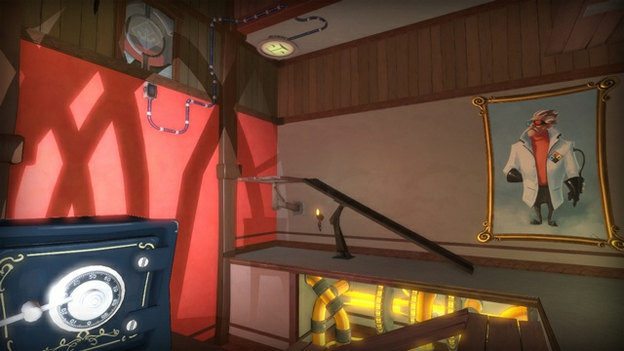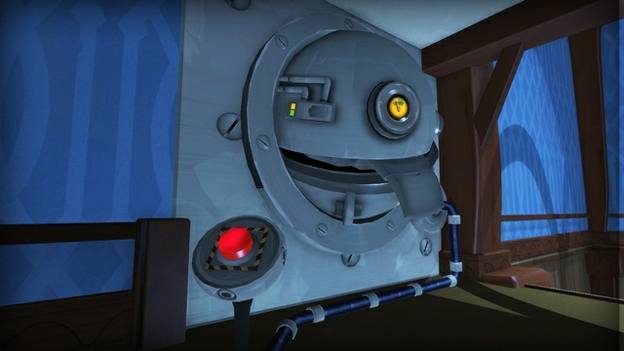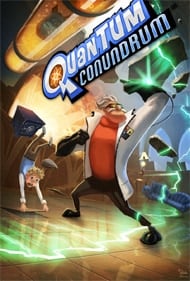After Portal
Up until now, the Portal games have had the 3D first-person puzzle genre pretty much to themselves. But no longer. Kim Swift, one of the main brains behind Portal—she helped create Narbacular Drop, the student project Portal was based on, and served as lead designer of the final product—has left Valve and shamelessly used much of what she learned to make Quantum Conundrum. In some ways, the game is almost uncomfortably similar to what came before it—but it’s also nearly as good. And it’s selling at a $15 price point. So for Portal fans, this is a must-buy.

The formula will be instantly familiar to anyone who’s played Portal or Portal 2. You’re in a facility that contains a series of puzzles, and there’s an authority figure directing you through them while providing humorous commentary. The puzzles rely heavily on 3D physics, require some platforming chops here and there, and allow you to make changes to your environment to get where you’re going. There are lots of lasers. Between each puzzle there is some basic navigation—in this case a hallway rather than an elevator, in addition to some doors—to mask the loading times. Once you complete the campaign, you can try to win some additional challenges, such as solving the puzzles within a time limit or using the lowest number of moves possible.
Of course, that’s not to say that Swift and Co. outright remade Portal. For starters, the basic mechanics have been completely remade. Your portal gun is gone, replaced with a special glove that allows you to change various things about the room you’re in. Each puzzle provides you with a certain set of modules for the glove. You might be able to make the entire room “fluffy”—that is, one-tenth its usual weight—so that you can pick up a heavy safe, put it on a button, and then make the room normal again so the safe’s weight pushes the button. There’s also a module that makes everything in the room heavy, one that slows down time, and one that reverses gravity.

Much like the different-colored paints in Portal 2, these modules give the developers a lot of options when it comes to designing levels. While there are some “pick up this box and put it over there”-type puzzles, the majority of them are rather elaborate, requiring deep thought and careful consideration of all the options. And the genius behind Portal’s level design truly shines through here—plenty of the puzzles are tough and counterintuitive, but none of them are so hard that you’ll become frustrated. As was the case with Portal, you normally feel “plugged in”—intensely engaged, but not twitchy or irritable—when you’re playing Quantum Conundrum.
Swift also tried to completely change the atmosphere of Portal to make Quantum Conundrum distinct, but unfortunately, this doesn’t work nearly as well. You are not a prisoner in Quantum Conundrum; instead, you’re a small child visiting his uncle, a crazy scientist who loves to tool with the laws of nature. Your uncle gets himself trapped in another dimension, and you need to explore his house to figure out how to bring him back. That’s a fine idea, but the implementation leaves something to be desired.

Whereas Portal has a clinical feel, with a savage undercurrent of violence and dark humor, Quantum Conundrum goes for a whimsical and quirky vibe that reminded me a little of Psychonauts. (Both games share the “little kid with superpowers at his disposal” element.) It doesn’t quite pull it off. The graphics, delivered via Unreal 3 instead of the Source engine, present the house to you in warm, welcoming colors, but there isn’t very much variety in the environments. The music has a bass-heavy, jazzy feel, but at times it can be cheesy and annoying. And worst of all, your uncle, Professor Quadwrangle, just isn’t nearly as funny as GLaDOS, Wheatley, or Cave Johnson. His humor sounds forced and dorky.

Basically, when it comes to presentation, as opposed to mechanics and level design, Quantum Conundrum simply pales in comparison with Portal, not to mention Portal 2. Though to be fair, given Quantum Conundrum’s price, the former is a much fairer point of comparison.
The controls here are basically what you’d expect for a first-person game, though Portal fans might be a little put off by one decision if they play on PC. Because there’s no portal gun here, the developers were free to use the mouse buttons for whatever they wanted. They chose to use them for picking up items, throwing them, and interacting with the environment. Most PC gamers are used to pushing the E button for basic interactions, and that’s a hard habit to break. So, picky gamers with options might want to wait for the XBLA and PSN versions of Quantum Conundrum, which are due out next month.
Quantum Conundrum is by no means a perfect game. But it’s an incredibly enjoyable one that preserves the spirit of Portal, introduces some fascinating new mechanics, and provides players with a great new set of puzzles. At $15, that’s a steal, plain and simple.
RATING OUT OF 5 RATING DESCRIPTION 3.5 Graphics
The colors are warm and inviting, but the environments don’t have much variety. 4.0 Control
They’re standard, though basic interactions should have been mapped differently. 2.8 Music / Sound FX / Voice Acting
The jazzy songs can be kind of annoying. 4.5 Play Value
The campaign is short, but it’s great, and the price is low. 4.3 Overall Rating – Great
Not an average. See Rating legend below for a final score breakdown.
| Review Rating Legend | |||
|---|---|---|---|
| 0.1 – 1.9 = Avoid | 2.5 – 2.9 = Average | 3.5 – 3.9 = Good | 4.5 – 4.9 = Must Buy |
| 2.0 – 2.4 = Poor | 3.0 – 3.4 = Fair | 4.0 – 4.4 = Great | 5.0 = The Best |
Game Features:
